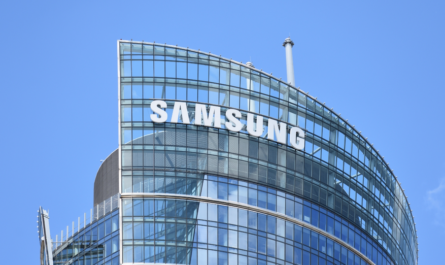In a dramatic turn of events, Nvidia briefly surpassed Apple to become the world’s most valuable company, only to see its momentum disrupted by renewed volatility in the global semiconductor market.
The turbulence came after ASML, the Dutch semiconductor equipment giant, slashed its 2025 sales forecast, sending shockwaves through the industry and wiping out an estimated $420 billion in global chip sector value in a single day.
The incident highlights both the fragility and the interconnected nature of today’s semiconductor ecosystem — where the optimism around artificial intelligence (AI) and chip innovation can be quickly overshadowed by broader market concerns.
ASML’s Forecast Cuts Shake Investor Confidence
On October 15, ASML stunned investors with a revised 2025 revenue outlook that fell significantly below prior expectations.
The company, which is the exclusive supplier of extreme ultraviolet (EUV) lithography machines used in advanced chipmaking, announced that it now expects net sales between $32 billion and $38 billion for 2025.
This marks a sharp reduction from its earlier forecast of $43.5 billion, underscoring the cooling demand for non-AI semiconductor products such as memory chips, mobile processors, and automotive components.
ASML’s announcement sent immediate ripples across global markets. The company’s stock plummeted 16% on the day of the announcement — its largest single-day loss in over 25 years — wiping out approximately $54 billion in market capitalization.
According to Reuters, the revised guidance reflects ongoing headwinds in consumer electronics and data center investment, which have yet to fully recover from post-pandemic slowdowns.
A $420 Billion Global Market Rout
The sell-off quickly spread across the semiconductor sector.
Major Asian chipmakers bore the brunt of the downturn:
-
Samsung Electronics shares fell 2.3%,
-
Taiwan Semiconductor Manufacturing Company (TSMC) dropped 2.5%, and
-
Leading U.S. chipmakers AMD, Intel, Arm, and Broadcom also declined sharply.
The widespread retreat pushed the Philadelphia Semiconductor Index down by 5%, marking one of the steepest declines of 2024.
Investors reacted swiftly to the ASML downgrade, viewing it as a potential warning signal for the entire chipmaking industry — particularly those dependent on cyclical demand outside of the booming AI sector.
Nvidia and Apple: A Tug-of-War for the Top Spot
The timing of ASML’s announcement added further drama to the market.
Just one day earlier, Nvidia had briefly overtaken Apple to become the most valuable company in the world, driven by its dominance in AI hardware and unprecedented stock market momentum.
However, the celebration was short-lived. Following ASML’s gloomy forecast, Nvidia’s shares fell 4.5%, wiping out roughly $158 billion in market capitalization.
The setback has cast doubt on whether Nvidia’s meteoric rise can continue amid broader instability in the chip sector.
Apple, despite its own challenges — including slowing iPhone sales and antitrust scrutiny — managed to reclaim the top valuation spot as investors pulled back from semiconductor-heavy portfolios.
A Familiar Pattern of Volatility
This latest sell-off mirrors similar episodes that have rocked the semiconductor industry in recent years.
In August 2024, Arm Holdings issued a cautious earnings forecast that triggered another sharp correction in chip stocks. At the time, Arm’s shares tumbled 16%, leading to the worst day for U.S. semiconductor equities since 2020.
Analysts drew parallels between the current downturn and that event, suggesting that the AI-fueled rally may have reached a temporary saturation point.
While demand for AI chips — particularly Nvidia’s graphics processing units (GPUs) — remains robust, the broader chip market tied to consumer electronics, personal computers, and mobile devices continues to struggle with oversupply and weaker margins.
AI Boom vs. Broader Chip Weakness
The semiconductor market has become increasingly divided between AI-driven growth and traditional chip demand.
Companies like Nvidia, AMD, and Broadcom have seen extraordinary gains thanks to skyrocketing demand for AI accelerators and data center chips used by tech giants such as Amazon, Microsoft, Alphabet, and Meta.
However, this surge has not been enough to offset sluggishness in other segments. Memory chipmakers, smartphone component suppliers, and automotive chip producers have reported slower order volumes and tightening profit margins.
ASML’s lowered forecast, therefore, reflects a wider market correction — suggesting that while AI demand is booming, the rest of the semiconductor ecosystem remains in recovery mode.
Global Economic Pressures Add to Uncertainty
Beyond industry-specific factors, global economic conditions are also weighing on the semiconductor outlook.
High interest rates, inflationary pressures, and reduced corporate spending on hardware have collectively tempered expectations for chip sales.
In particular, China’s weakening demand and the continuing U.S.-China tech tensions have disrupted global chip supply chains and investment flows.
ASML, which is heavily dependent on export licenses to supply equipment to China, continues to face geopolitical headwinds that could further limit growth potential.
Investor Reactions and Market Sentiment
Market analysts remain divided on how long the current slump will last.
Some believe that the sell-off is temporary, arguing that semiconductor fundamentals remain strong in the long term due to sustained demand for high-performance computing, 5G infrastructure, and AI innovation.
Others warn that the sector may be entering a consolidation phase, where overvaluation and speculative trading could lead to more frequent corrections.
Despite the short-term volatility, several analysts maintain buy ratings on Nvidia, TSMC, and ASML — viewing the current pullback as a potential entry point for long-term investors.
According to a recent note from Goldman Sachs, “AI continues to be the most powerful growth catalyst in technology, and while cyclical fluctuations will persist, the structural demand for compute power remains unshaken.”
Looking Ahead: Hope for Recovery in 2025
While 2024 has proven turbulent, many within the industry are cautiously optimistic about 2025.
TSMC’s upcoming earnings reports are expected to offer clearer insights into the health of the global chip supply chain and whether AI demand can sustain the sector’s growth trajectory.
Analysts predict that as new AI-enabled devices, cloud infrastructure, and next-generation computing platforms come online, the semiconductor market will gradually stabilize and rebound.
For now, however, ASML’s cautious forecast has injected a dose of realism into what had been an increasingly euphoric market.
Conclusion: A Reminder of Volatility in the AI Age
The events of this week underscore the dual nature of the semiconductor boom — where groundbreaking innovation and soaring valuations coexist with deep uncertainty and cyclical risk.
Nvidia’s brief stint as the world’s most valuable company may have symbolized the dominance of AI in modern tech, but ASML’s downgrade served as a reminder that even the strongest sectors are vulnerable to shifts in demand and sentiment.
As investors recalibrate their expectations, the semiconductor industry enters its next chapter — one defined not only by technological progress, but by the constant balancing act between optimism and caution.




